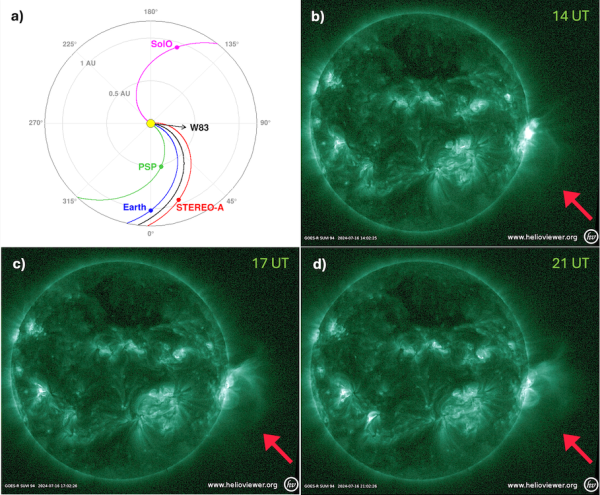On the Origin of Solar Long-Duration Gamma-Ray Flares
| Nugget | |
|---|---|
| Number: | 509 |
| 1st Author: | Alessandro BRUNO |
| 2nd Author: | et al. |
| Published: | November 3, 2025 |
| Next Nugget: | TBD |
| Previous Nugget: | FAI and GOES eclipses |
Introduction
Long-duration gamma-ray flares (LDGRFs) are solar events in which >100 MeV γ-ray emission persists up to tens of hours after the flare impulsive phase. These photons are mostly produced in the interaction as secondary emissions, following the primary interactions of of >300 MeV protons and >200 MeV/n α-particles in the photosphere. These produce copious pions that quickly decay, with γ-ray emission. Notably the mechanism accelerating the parent ions remains unresolved. Two leading scenarios are (a) back-propagation of particles accelerated at shock waves driven by coronal mass ejections (Ref. [1]); and (b) particle trapping with stochastic acceleration inside large-scale coronal loops (Ref. [2]). Support for the CME/shock paradigm mainly comes from observed statistical associations between LDGRFs, fast CMEs and large solar energetic particle (SEP) events, yet these correlations — driven by biggest events — are neither universal nor proof of causation (Ref. [3]). A challenging counter-example can be found in the SOL2024-07-16 event, described here and in our paper (Ref. [4]).
Observations
The parent GOES class X1.9 flare peaked at 13:26 UT and was at the western limb (S05W83). Fermi/LAT began detecting >100 MeV γ-rays around 14 UT, with emission continuing for ~7 hours (see Figure 1). The measured photon energies exceeded 1 GeV, and the inferred parent ion spectrum was among the hardest reported. In contrast, the accompanying CME was relatively slow (~600 km/s); the associated type-II radio burst was faint and short-lived, not extending to kHz frequencies; and, as shown in Figure 2, SEP signatures were weak and limited to a few tens of MeV, even at magnetically well-connected locations (see Figure 3a), with a barely-visible increase in the GOES >10 MeV proton channel. Meanwhile, giant coronal loops appeared around 13:30 UT in the 94 EUV images from SDO/AIA and GOES/SUVI, persisting well beyond the end of the LDGRF (see Figure 3b-d).


Discussion
All the shock-related phenomena accompanying this event were weak and exhibited no apparent link with the γ-ray emission. This suggests that the CME-driven shock was not strong enough to accelerate ions to energies well above the pion-production threshold needed to account for the measured γ-ray emission. The alternative coronal-loop origin scenario is instead favored by the observation of large-scale structures of hot plasma over the source region for the entire duration of this LDGRF.
Conclusions
The 2024 July 16 event demonstrates that a very fast CME resulting in a high-energy SEP event in the interplanetary space is not a necessary condition for the occurrence of an LDGRF. These findings challenge the idea that the high-energy γ-ray emission is produced by the back-precipitation of ions accelerated at CME-driven shocks into the solar surface.
Acknowledgements
The co-authors of this Nugget and Ref. [4] are M. Pesce-Rollins, S. Dalla, N. Omodei, I.G. Richardson and J.M. Ryan
References
[1] [https://ui.adsabs.harvard.edu/abs/1993ICRC....3...91C "On the Origin of Gamma-Ray Emission from the Behind-the-Limb Flare on 29 September 1989"]
[2] "On the Transport and Acceleration of Solar Flare Particles in a Coronal Loop"
